|
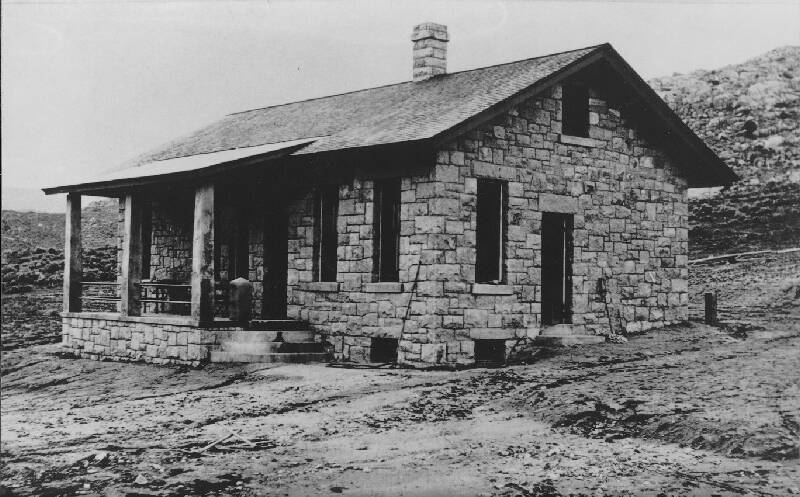
Dam Keepers House, Pathfinder Dam, 1906
Portions of the North Platte are among the most modified of the rivers of the west. Seven dams create reservoirs
along its course, the Seminoe, photo below, and Kortes dams upstream from the Pathfinder Reservoir and the Alcova,
Gray Reef, Glendo and Guernsey downstream.
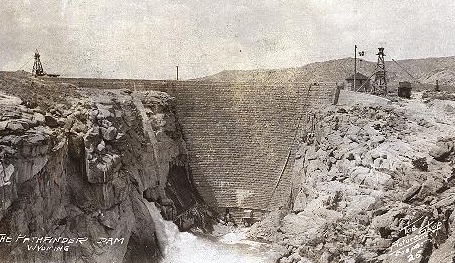
Pathfinder Dam, 1922 The oldest of the dams is the Pathfinder located about 45 miles
southwest of Casper at the confluence with the Sweetwater. The dam, one of the first constructed by the
Reclamation Service, was started in 1905 and completed in 1909. Difficulties were experienced in construction including even obtaining
a contractor. The first bidder, Bradbury & O'Gara of Denver withdrew their bid after reviewing
local conditions. The next bidder N.S. Sherman of Oklahoma City did not have the financial
ability to carry out the project. Ultimately, the contract was awarded to Geddis and Seerie Stone Co. of Denver for $428,000.
With cost overruns, however, the project cost climbed to $626,523.52. Other projects
undertaken by the firm included the Colorado State House, the Brown Palace Hotel, the
Omaha Post Office and the Cheesman Dam which provided water for Denver. The diversion tunnel carrying the
river around the dam site and ultimately serving as the outlet for the reservoir was
constructed by Kilpatrick Brothers and Collins Contracting Company.
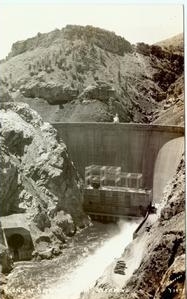 Seminoe Dam, constructed 1936-1939 Seminoe Dam, constructed 1936-1939
The weather was of little help in the construction of the Pathfinder. Initial excavation to bedrock was
delayed while crews cut through ice as much as three feet thick in temperatures as low as
-29 F., followed in the spring by flooding. Thus, the first stones of the masonry
structure were not laid until August of 1906. Indeed, the weather had its final revenge
in 1909. During the last month of construction the weather again took its toll, alternating
between cold, rain and wind.
The Seminoe Dam, 31 miles northeast of Rawlins, was constructed between 1936 and 1939. The
reservoir provides hydro-electric power and water for
irrigation, with water being released as necessary to the Pathfinder downstream. As with the
Pathfinder, weather still provides problems. Freeze-thaw has caused cracking in
the concrete structure requiring refurbishment and monitoring. Access to the
power plant is on occassion obstructed by rockslides in the narrow canyon also requiring
maintainance and extra expense.
As noted on Ghost IV, the name "Seminoe" is an
Anglicizing of Cimineau. The Seminoe Mountains and
Reservoir are named after Basil Cimineau LaJeunesse,
a French-Louisianan guide who accompanied each of the three Fremont
expeditions including the 1843 expedition along the Platte and Sweetwater.
LaJeunesse was killed by Klamath Indians in May, 1846, near Klamath Lake,
Oregon. The name was applied first to the area by LaJeunesse's brother, Charles LaJeunesse.
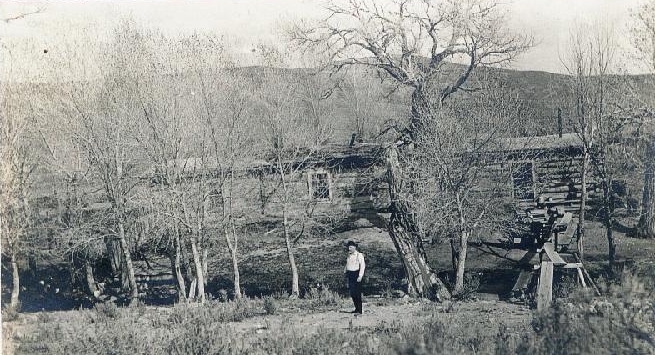
Bonaparte Napoleon "Boney" Earnest at Pathfinder Ranch, 1907
Boney Earnest was a well known scout in Carbon County at the
turn of the Century. He had served as an army scout along with Tom Sun under Anson Mills in the
Powder River campaign of 1876. Mills flunked out of West Point in 1859 and notwithstanding
that he came from Texas served in the Union Army during the Civil War. His brother, W. W. Mills,
stayed in Texas as a Union spy. His other brother, Emmett Mills, caught the last stage out
of El Paso but was killed when Apaches attacked the coach. The Pathfinder Ranch, still in business, lies adjacent to the
Reservoir. On its lands is the grave of Ellen "Cattle Kate" Watson. See Home for the
story of her lynching. Tom Sun became a rancher and owned the 3,000,000 acre Sun
Ranch near Devil's Gate.
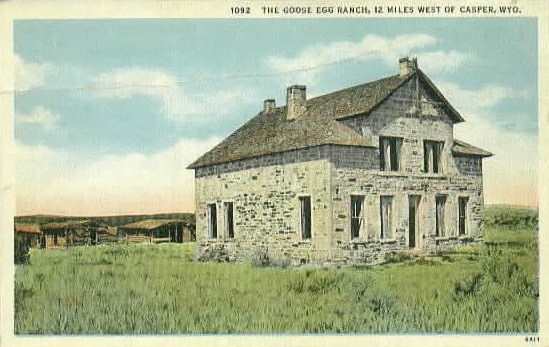
Goose Egg Ranch
View of the Goose Egg Ranch,
torn down in 1960, located at
Bessemer Bend featured in Owen Wister's The Virginian. The ranch house was designed by its owners the
Searight Brothers to be able to withstand Indian raids. The Goose Egg received its
name when several cowboys found a goose nest with eggs and took the eggs to the cook who bore the name
"Old Over Slope". The eggs gave Gilbert Searight insiration for the brand which would be
easy to make and apply. Old Over Slope received his name as a result of his ears being lost to
frost bite giving him an unusual appearance. The Searight Brothers sold out to
J.M. Carey and Brother, discussed on the next page, in 1885. The ranch was located
on a rise on the north bank of the river. For another photo of
the Goose Egg, see the the Casper College Collection above.
Bessemer Bend, also referred to as Red Buttes, on the North Platte west of Casper,
was the location of the first cabin in Wyoming, constructed
in November 1825 by the Astorians under Robert Stuart at the confluence of the North
Platte and Poison Spider Creek.

Bessemer Bend, 1981
Photo courtesy Library of Congress, Prints and Photographs Division
Bessemer Bend provided emigrants on the Oregon Trail
an easy location to ford the river and thus avoid the tolls on the Mormon Ferry at Casper.
As noted on the next page, Bessemer lost out to Casper as the location for the county seat.
In the 1880's and 90's Bessemer had a hotel, the Searight House, and served as the headquarters for
the Casper-Rongis Stage Line, owned by William Clark and Son and which provided service from Casper to Lander.
Clark also engaged in ranching near Natrona, 24 miles west of Casper. Natrona today consists of little more
than a combination gas station and bar.
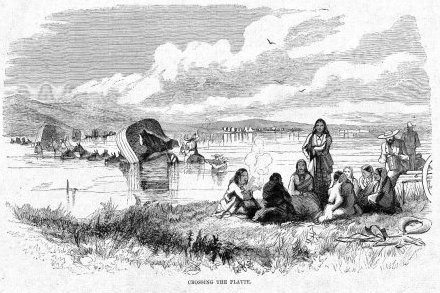
Crossing the Platte, A. Bierstadt, woodcut, 1859
Near Bessemer Bend the Martin Handcart Company was snowbound for 10 days and 56
perished. In October 1856 the Company forded the river, wading across, dodging ice floes and was caught by a
sleet and snow storm.
One of the survivors from the Company, Elizabeth Horrocks Jackson, described the death of
her husband:
"Some of the men carried some of the women on their back or in their arms,
but others of the women tied up their skirts and waded through,
like the heroines that they were, and as they had gone through
many other rivers and creeks. My husband (Aaron Jackson) attempted
to ford the stream. He had only gone a short distance when he reached
a sandbar in the river, on which he sank down through weakness
and exhaustion. My sister, Mary Horrocks Leavitt, waded through
the water to his assistance. She raised him up to his feet. Shortly
afterward, a man came along on horseback and conveyed him to the
other side. My sister then helped me to pull my cart with my three
children and other matters on it. We had scarcely crossed the river
when we were visited with a tremendous storm of snow, hail, sand, and
fierce winds. . . .
"About nine o'clock I retired. Bedding had become very scarce so I did
not disrobe. I slept until, as it appeared to me, about midnight. I
was extremely cold. The weather was bitter. I listened to hear if my
husband breathed, he lay so still. I could not hear him. I became alarmed.
I put my hand on his body, when to my horror I discovered that my worst
fears were confirmed. My husband was dead. I called for help to the other
inmates of the tent. They could render me no aid; and there was no
alternative but to remain alone by the side of the corpse till morning.
Oh, how the dreary hours drew their tedious length along. When daylight
came, some of the male part of the company prepared the body for burial.
And oh, such a burial and funeral service. They did not remove his
clothing—he had but little. They wrapped him in a blanket and placed
him in a pile with thirteen others who had died, and then covered him
up with snow. The ground was frozen so hard that they could not dig a
grave. He was left there to sleep in peace until the trumpet of God shall
sound, and the dead in Christ shall awake and come forth in the morning
of the first resurrection. We shall then again unite our hearts
and lives, and eternity will furnish us with life forever more."
(Elizabeth Jackson, as quoted in LeRoy and Ann Hafen, Handcarts to Zion
[Glendale, Ca.: The Arthur H. Clark Company, 1960], 110-13.)
North Platte photos continued on next page.
|